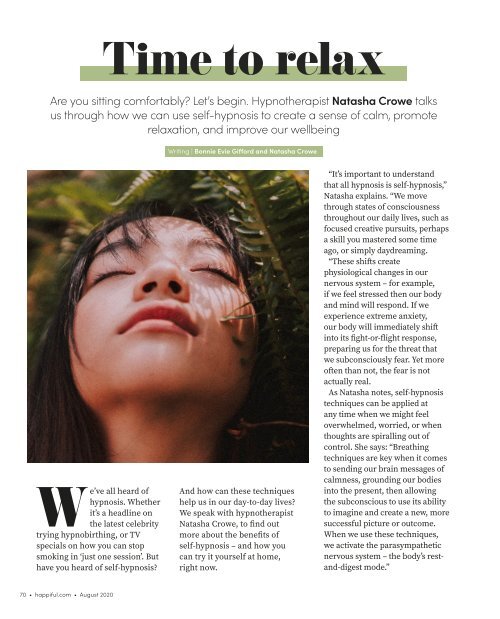Happiful August 2020
Create successful ePaper yourself
Turn your PDF publications into a flip-book with our unique Google optimized e-Paper software.
Time to relax<br />
Are you sitting comfortably? Let’s begin. Hypnotherapist Natasha Crowe talks<br />
us through how we can use self-hypnosis to create a sense of calm, promote<br />
relaxation, and improve our wellbeing<br />
Writing | Bonnie Evie Gifford and Natasha Crowe<br />
We’ve all heard of<br />
hypnosis. Whether<br />
it’s a headline on<br />
the latest celebrity<br />
trying hypnobirthing, or TV<br />
specials on how you can stop<br />
smoking in ‘just one session’. But<br />
have you heard of self-hypnosis?<br />
And how can these techniques<br />
help us in our day-to-day lives?<br />
We speak with hypnotherapist<br />
Natasha Crowe, to find out<br />
more about the benefits of<br />
self-hypnosis – and how you<br />
can try it yourself at home,<br />
right now.<br />
“It’s important to understand<br />
that all hypnosis is self-hypnosis,”<br />
Natasha explains. “We move<br />
through states of consciousness<br />
throughout our daily lives, such as<br />
focused creative pursuits, perhaps<br />
a skill you mastered some time<br />
ago, or simply daydreaming.<br />
“These shifts create<br />
physiological changes in our<br />
nervous system – for example,<br />
if we feel stressed then our body<br />
and mind will respond. If we<br />
experience extreme anxiety,<br />
our body will immediately shift<br />
into its fight-or-flight response,<br />
preparing us for the threat that<br />
we subconsciously fear. Yet more<br />
often than not, the fear is not<br />
actually real.<br />
As Natasha notes, self-hypnosis<br />
techniques can be applied at<br />
any time when we might feel<br />
overwhelmed, worried, or when<br />
thoughts are spiralling out of<br />
control. She says: “Breathing<br />
techniques are key when it comes<br />
to sending our brain messages of<br />
calmness, grounding our bodies<br />
into the present, then allowing<br />
the subconscious to use its ability<br />
to imagine and create a new, more<br />
successful picture or outcome.<br />
When we use these techniques,<br />
we activate the parasympathetic<br />
nervous system – the body’s restand-digest<br />
mode.”<br />
70 • happiful.com • <strong>August</strong> <strong>2020</strong>

















